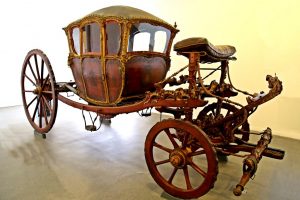In September 1668, the young Crown Prince Cosimo de Medici, heir of the Grand Duchy of Tuscany, left Florence accompanied by a distinguished entourage of intellectuals and noblemen. He started a journey that would take him through lands of the Iberian Peninsula to Santiago de Compostela.
The prince had a particularly devout character, greatly influenced by his mother, the Grand Duchess Victoria della Rovere, and modelled by the Jesuits. Hence, he liked to visit the great Catholic sanctuaries. However, that was not the main reason for his trip. For the education of a future ruler, the direct knowledge of what was still one of the most influential monarchies in Europe, to which the Grand Duchy of Tuscany owed much of its own existence, was particularly advisable.
There were also reasons of a personal nature. His marriage to a French princess, Margaret Louise d’Orleans was a constant source of distress. The personality of the young girl, flighty, proud and keen for amusements could hardly be suitable to match that of his pious, reserved and somewhat prudish husband. The opportunity of a long trip which would avoid for a season the troubles of coexistence, was suggested by the own father of Cosimo, the Grand Duke Ferdinando II.

In quality of “comrades”, as the documents say, the Grand Duke appointed Paolo Falconieri, architect, painter and mathematician, member of a noble Florentine family; Count Lorenzo Magalotti, secretary of the so-called Academia del Cimento, a scientific society, founded by Cardinal Leopold de Medici, who folled the methods of Galileo; the marquises Philippo Corsini and Vieri Guadagni and the doctor Giovanni Battista Gornia. Among them all, the most outstanding personality is that of Lorenzo Magalotti, to whom we owe the most extensive and detailed chronicle of the trip. As a complement to it, we have also the more or less detailed diaries kept by the Marquis Corsini and the doctor Gornia.
On this journey, the Gran Duke has also the brilliant idea of including an artist in the entourage, Pier Maria Baldi, in order to register all the places where the prince stopped. Currently the most renowned work of this painter is precisely the series of watercolours that accompany the text of Magalotti in the codex of the Laurentian Library.
On September 18th, 1668, at morning, the prince of Florence departed in carriage, accompanied by these comrades and followed by the retinue of his servitude, toward Livorno. There he embarked on a Tuscan galley which took him, bordering the Ligurian and then the French coastline, to the Gulf of Leon and the Spanish shore. On September 24th they anchored in Cadaqués, the first port of the Spanish Crown; the 27th they did it in Roses, the 28th in Palamós, after a painful navigation; and eventually the 29th they sighted Barcelona, goal of the maritime journey and starting point for the tour toward the interior of the Peninsula.

01 Harp Concerto op 4 no 6, Andante
